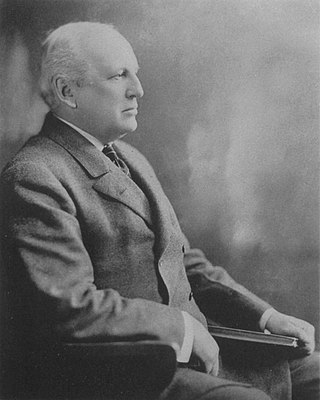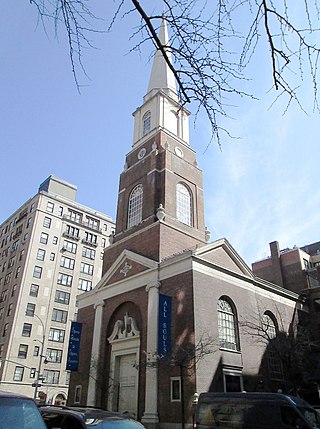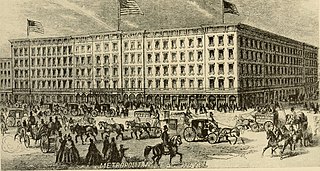
Unity Temple is a Unitarian Universalist church in Oak Park, Illinois, and the home of the Unity Temple Unitarian Universalist Congregation, which originally formed in 1871. It was designed by the American architect Frank Lloyd Wright, and built between 1905 and 1908. Unity Temple is considered to be one of Wright's most important structures dating from the first decade of the twentieth century. Because of its consolidation of aesthetic intent and structure through use of a single material, reinforced concrete, Unity Temple is considered by many architects to be the first modern building in the world. This idea became of central importance to the modern architects who followed Wright, such as Ludwig Mies van der Rohe, and even the post-modernists, such as Frank Gehry. In 2019, along with seven other buildings designed by Wright in the 20th century, Unity Temple was added to the UNESCO World Heritage List.

Samuel Atkins Eliot II was an American Unitarian minister. In 1898 the American Unitarian Association elected him secretary but in 1900 the position was redesignated as president and Eliot served in that office from inception to 1927, significantly expanding the association's activities and consolidating denominational power in its administration.
Broadway United Church of Christ is a Congregationalist Church located on West 71st Street, between Amsterdam Avenue and Columbus Avenue on the Upper West Side of Manhattan.

Niblo's Garden was a theater on Broadway and Crosby Street, near Prince Street, in SoHo, Manhattan, New York City. It was established in 1823 as "Columbia Garden" which in 1828 gained the name of the Sans Souci and was later the property of the coffeehouse proprietor and caterer William Niblo. The large theater that evolved in several stages, occupying more and more of the pleasure ground, was twice burned and rebuilt. On September 12, 1866, Niblo's saw the premiere of The Black Crook, considered to be the first piece of musical theater that conforms to the modern notion of a "book musical".

The Unitarian Church of All Souls at 1157 Lexington Avenue at East 80th Street in the Upper East Side of Manhattan, New York City was built in 1932 and was designed by Hobart Upjohn – Richard Upjohn's grandson – in the Neo-colonial style with a Regency-influenced brick base. It is the congregation's fourth sanctuary. The congregation, dating back to 1819, was the first Unitarian Universalist congregation in the city. It has provided a pulpit for some of the movement's leading theologians and has also recorded many eminent persons in its membership.

First Unitarian Congregational Society in Brooklyn is a Unitarian Universalist congregation in Brooklyn, NY. The Society was established in 1833 and has been worshiping in its historic Gothic Revival Sanctuary since 1844. The Sanctuary is adorned with stained glass windows and a Louis C. Tiffany angel mosaic. It is one of the earliest Unitarian congregations in the United States, established just 8 years after the American Unitarian Association was formed in 1825.

Isham Park is a 20-acre (81,000 m2) historic park located in Inwood, Manhattan, New York City. The park was created in large part through gifts to the city from the Isham family of land from the William Bradley Isham estate. It sits roughly between Broadway, Isham Street, Seaman Avenue, and West 214th and 215th Streets.

The Metropolitan Hotel in Manhattan, New York City, opened September 1, 1852, and was demolished in 1895. It was built at a time of a "hotel boom" in response to the opening of the New York Crystal Palace exhibition of 1853.

The Nippon Club of New York City is a private social club on 57th Street in Midtown Manhattan, New York City, founded in 1905 by Jōkichi Takamine for Japanese Americans and Japanese nationals. The only Japanese traditional gentlemen's club in the United States, the Nippon Club's dual purpose is to help enhance the unity of the Japanese community in New York City and to help develop evolving relationships with the American people. Over the course of its first century, the Nippon Club has fostered ongoing business and cultural relationships through various events, workshops, cultural classes and athletic events.
The Church of St Gregory the Great is a Roman Catholic parish located on the Upper West Side of Manhattan, New York City. The parish is part of the Archdiocese of New York. The church building, designed by architect Elliott Lynch, contains the church and parish offices on the ground floor with St. Gregory the Great Parochial School on the next two floors above, the final fourth floor is occupied by the rectory. The address of the church is 144 West 90th Street, New York, New York 10024-1202; the address of the school is 138 West 90th Street, New York, NY 10024.

The Second Congregational Church in New York, organized in 1825, was a Unitarian congregation which had three permanent homes in Manhattan, New York City, the second of which became a theater after they left it. In 1919 the congregation joined the Community Church Movement and changed its name to Community Church of New York. The same year, its church building on 34th Street was damaged by fire. From 1948 until 2022, the congregation was housed at 40 East 35th Street. As of 2024, the church offices are located on East 35th Street and services are held at the neighboring Church of the Incarnation. The Community Church of New York is a member of the Unitarian Universalist Association.

The Madison Square North Historic District is in Manhattan, New York City, and was created on June 26, 2001, by the city's Landmarks Preservation Commission.
First Unitarian Church of Los Angeles is an independent congregation affiliated with the Unitarian Universalist Association of Congregations. Since its founding in 1877 the church has been a leader in social justice activism for the Unitarian Universalist faith, and for the city of Los Angeles. Its embrace of progressive causes and sometimes radical politics have earned it a reputation as both a place of controversy and a beacon of justice. Its affiliated organization, Urban Partners Los Angeles, provides numerous programs in the neighborhood around the church.
The Quaker Meeting-house on Hester and Elizabeth Streets, in the Lower East Side of Manhattan, New York City, was a meetinghouse for the Religious Society of Friends, built in 1818. Recorded in 1876 by the New York Express that it "has for a long time been the office of the New York Gas Light Company", now Consolidated Edison. It was presumed demolished.

St. Benedict the Moor Church was a Black Catholic parish church in the Archdiocese of New York, located at 342 West 53rd Street, Hell's Kitchen, Manhattan (Clinton), New York City. The property was sold to a developer in 2023.
Saint Stephen's Episcopal Church in Manhattan, New York City, was founded in 1805 as the fifth Episcopal parish in the Episcopal Diocese of New York. The stone church, on the southeast corner of Broome and Chrystie Streets, was inaugurated on Saint Stephen's Day, December 26, 1805. By 1866 the congregation had largely moved uptown, and the rector Rev. Joseph H. Price convinced the trustees to sell the old structure, which was demolished. In 1873 Saint Stephen's merged with the Church of the Advent on West 46th Street, then in 1897 the parish purchased a simple brick chapel of the Church of the Transfiguration that had been built in 1880 on West 69th Street in the newly-developing Upper West Side. The first service of Saint Stephen’s Church was held there on October 3, 1897. The unpretentious church, set in a remnant of its suburban garden, is now the oldest church structure in the Upper West Side.
The Anita Shapolsky Gallery is an art gallery that was founded in 1982 by Anita Shapolsky. It is currently located at 152 East 65th Street, on Manhattan's Upper East Side, in New York City.

The Unitarian Universalist Church of Lancaster is a Unitarian Universalist church located at 538 West Chestnut Street, Lancaster, Pennsylvania. The church building is part of the Historic District of the City of Lancaster. The congregation is a member of the Unitarian Universalist Association, in the Association's Central East Region. Like all Unitarian Universalist churches, it is noncreedal, covenantal and religiously liberal. According to the UUA, the Lancaster church currently has 275 members and is an LGBTQIAA+ Welcoming Congregation.












